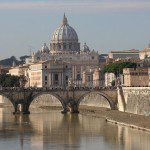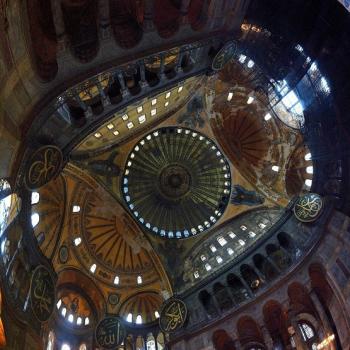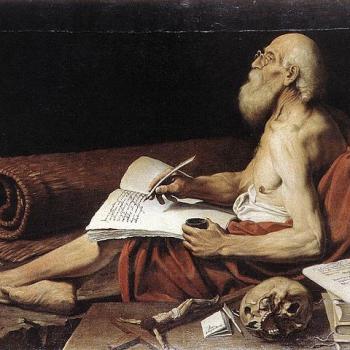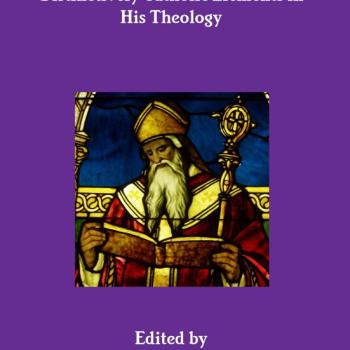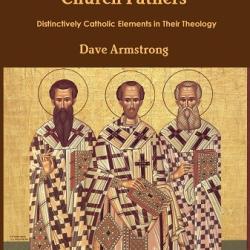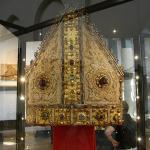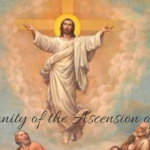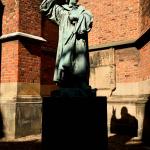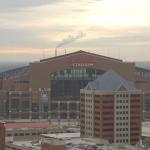Featuring Much Documentation from St. Augustine, St. Vincent of Lerins, St. Thomas Aquinas. Vatican I, Popes Pius IX, Pius X, Etc.
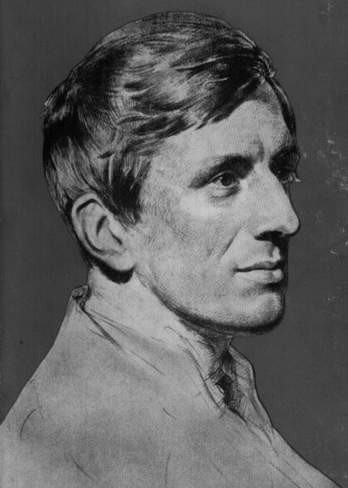
Blessed John Henry Cardinal Newman (1801-1890): 1844 crayon portrait by George Richmond (1809-1896) [public domain / Wikimedia Commons]
***
(3-19-02)
*****
Against Heresies, 3, 24, 1
The preaching of the Church truly continues without change and is everywhere the same, and has the testimony of the Prophets and the Apostles and all their disciples . . . That in which we have faith is a firm system directed to the salvation of men; and, since it has been received by the Church, we guard it. Constantly it has its youth renewed by the Spirit of God, as if it were some precious deposit in an excellent vessel; and it causes the vessel containing it also to be rejuvenated . . . For where the Church is, there is the Spirit of God; and where the Spirit of God, there the Church and every grace. The Spirit, however, is Truth. [From W. A. Jurgens (editor and translator), The Faith of the Early Fathers, Collegeville, Minnesota: The Liturgical Press, 1970, vol. 1 of 3, 94]
Origen (c. 185-254)
The Fundamental Doctrines, 1, Preface, 2-3
Although there are many who believe that they themselves hold to the teachings of Christ, there are yet some among them who think differently from their predecessors. The teaching of the Church has indeed been handed down through an order of succession from the Apostles, and remains in the Churches even to the present time. That alone is to be believed as the truth which is in no way at variance with ecclesiastical and apostolic tradition.
It ought to be known, however, that the holy Apostles, in preaching the faith of Christ, treated with the utmost clarity of certain matters which they believed to be of absolute necessity to all believers, even to those who seemed somewhat dull in regard to the investigation of divine knowledge. Naturally, they left the grounds of their assertions to be investigated by those who would deserve the excellent gifts of the Spirit, and to those who would receive in a pre-eminent degree through the same Holy Spirit the gifts of language, of wisdom, and of knowledge. In other matters, indeed, they stated that certain things are so; but as to the how and wherefore of their being so, they were silent. They did this, indeed, so that such of their successors as were more studious and who would be lovers of wisdom might have a subject of exercise on which to display the fruit of their talents — those persons, I mean, who should prepare themselves to be fit and worthy for the reception of wisdom. [From W. A. Jurgens (editor and translator), The Faith of the Early Fathers, Collegeville, Minnsota: The Liturgical Press, 1970, vol. 1 of 3, 190]
St. Gregory of Nyssa (c. 330-c. 395)
Catechetical Orations, 3
Truth passes in the mean between these two conceptions, destroying each heresy, and yet accepting what is useful to it from each. The Jewish dogma is destroyed by the acceptance of the Logos and by the belief in the Spirit, while the polytheistic error of the Greek school is made to vanish by the unity of the [divine] nature abrogating this notion of plurality. Yet again, of the Jewish conception, let the unity of the nature stand; and of the Greek, only the distinction as to persons . . . It is as if the number of the Trinity were a remedy in the case of those who are in error as to the One, and the assertion of the unity for those whose beliefs are dispersed among a number of divinities. [From Jaroslav Pelikan, The Christian Tradition: A History of the Development of Doctrine: vol. 1 of 5: The Emergence of the Catholic Tradition (100-600), Chicago: The University of Chicago Press, 1971, 66-67; PG 45:17-20]
St. Augustine (354-430)
City of God, Book 16, chapter 2
Chapter 2.-What Was Prophetically Prefigured in the Sons of Noah.
The things which then were hidden are now sufficiently revealed by the actual events which have followed. For who can carefully and intelligently consider these things without recognizing them accomplished in Christ? . . . even the heretics yield an advantage to those that make proficiency, according to the apostle’s saying, “There must also be heresies, that they which are approved may be made manifest among you.” Whence, too, it is elsewhere said, “The son that receives instruction will be wise, and he uses the foolish as his servant.” For while the hot restlessness of heretics stirs questions about many articles of the catholic faith, the necessity of defending them forces us both to investigate them more accurately, to understand them more clearly, and to proclaim them more earnestly; and the question mooted by an adversary becomes the occasion of instruction . . . These secrets of divine Scripture we investigate as well as we can. All will not accept our interpretation with equal confidence, but all hold it certain that these things were neither done nor recorded without some foreshadowing of future events, and that they are to be referred only to Christ and His church, which is the city of God, proclaimed from the very beginning of human history by figures which we now see everywhere accomplished . . .
Commentary on Psalm 55 (section 21)
(rephrased and sentence order changed in parts by Dave Armstrong for syntactical improvement; see for the very awkward, almost unreadable literal translation)
. . . by heretics the Catholic Church has been vindicated, . . . For many things lay hidden in the Scriptures: and when heretics, who had been cut off, troubled the Church of God with questions, then those things which lay hidden were opened, and the will of God was understood . . . Many men that could understand and expound the Scriptures very excellently, were hidden among the people of God, and they did not declare the solution of difficult questions, until a reviler again urged them. For was the doctrine of the Trinity perfectly expounded upon before the Arians snarled at it? Was repentance perfectly treated before the opposition of the Novatians? Likewise, Baptism was not perfectly understood, before rebaptizers from the outside contradicted; nor even the very oneness of Christ . . . until after this separation began to press upon the weak: in order that those who knew how to deal with and solve these questions (lest the weak should perish, vexed with the questions of the ungodly), should bring out into the open the dark things of the Law, by their discourses and disputations . . .
Confessions, VII, 19 [link]
I learned how in the sentence, The Word was made flesh,
the Catholic truth can be distinguished from the falsehood of Photinus. For the disapproval of heretics makes the tenets of Your Church and sound doctrine to stand out boldly. For there must be also heresies, that the approved may be made manifest among the weak.
The history of doctrines or dogmas . . . Its object is to show how the mind of the church has gradually apprehended and unfolded the divine truths of revelation, how the teachings of scripture have been formulated and shaped into dogmas, and grown into creeds and confessions of faith, or systems of doctrine stamped with public authority. This growth of the church in the knowledge of the infallible word of God is a constant struggle against error, misbelief, and unbelief; and the history of heresies is an essential part of the history of doctrines. Every important dogma now professed by the Christian church is the result of a severe conflict with error. (Philip Schaff, History of the Christian Church, vol. 1: Apostolic Christianity: A.D. 1-100, Grand Rapids, Michigan: Eerdmans, 1910 [orig. rev. ed. of 1980]; rep. 1975, 10)
Augustine . . . manifestly acknowledges a gradual advancement of the church doctrine, which reaches its corresponding expression from time to time through the general councils; but a progress within the truth, without positive error. (Ibid., vol. 3: Nicene and Post-Nicene Christianity, Grand Rapids, Michigan: Eerdmans, 1974 [orig. 1910], 344)
Within the limits of the Jewish theocracy and Catholic Christianity Augustin admits the idea of historical development or a gradual progress from a lower to higher grades of knowledge, yet always in harmony with Catholic truth. He would not allow revolutions and radical changes or different types of Christianity. “The best thinking” (says Dr. Flint, in his Philosophy of History in Europe, I. 40), “at once the most judicious and liberal, among those who are called the Christian fathers, on the subject of the progress of Christianity as an organization and system, is that of St. Augustin, as elaborated and applied by Vincent of Lerins in his ‘Commonitorium,’ where we find substantially the same conception of the development of the Church and Christian doctrine, which, within the present century, De Maistre has made celebrated in France, Mohler in Germany, and Newman in England. (Philip Schaff, Editor’s Preface to City of God, 38-volume set of the Church Fathers, December 10, 1886)
Dogma . . . is in the Scriptures. But the Scriptures do not offer this truth in formulated statements. Some matters are clearly expressed; others are only indicated. There is a need for a proper interpretation of Scripture which is guided by the “analogy of faith” (cf. Rom. 12:7) . . . The bent of mind and the individuality of certain leaders in the development of Christian thought must not be overlooked . . . Origen shows the Hellenistic type of mind; Tertullian, Cyprian, and Augustine the Latin type; Luther the German; and Calvin the French. (Otto W. Heick, A History of Christian Thought, vol. 1, Philadelphia: Fortress Press, 1965, 17-19)
St. Vincent of Lerins (d. c. 450)
The Commonitorium (Notebooks) (c. 434) [link]
Translated by C. A. Heurtley, D.D.
Chapter II. A General Rule for distinguishing the Truth of the Catholic Faith from the Falsehood of Heretical Pravity.
[4.] I Have often then inquired earnestly and attentively of very many men eminent for sanctity and learning, how and by what sure and so to speak universal rule I may be able to distinguish the truth of Catholic faith from the falsehood of heretical pravity; and I have always, and in almost every instance, received an answer to this effect: That whether I or any one else should wish to detect the frauds and avoid the snares of heretics as they rise, and to continue sound and complete in the Catholic faith, we must, the Lord helping, fortify our own belief in two ways; first, by the authority of the Divine Law, and then, by the Tradition of the Catholic Church.
[5.] But here some one perhaps will ask, Since the canon of Scripture is complete, and sufficient of itself for everything, and more than sufficient, what need is there to join with it the authority of the Church’s interpretation? For this reason, – because, owing to the depth of Holy Scripture, all do not accept it in one and the same sense, but one understands its words in one way, another in another; so that it seems to be capable of as many interpretations as there are interpreters. For Novatian expounds it one way, Sabellius another, Donatus another, Arius, Eunomius, Macedonius, another, Photinus, Apollinaris, Priscillian, another, Iovinian, Pelagius, Celestius, another, lastly, Nestorius another. Therefore, it is very necessary, on account of so great intricacies of such various error, that the rule for the right understanding of the prophets and apostles should be framed in accordance with the standard of Ecclesiastical and Catholic interpretation.
[6.] Moreover, in the Catholic Church itself, all possible care must be taken, that we hold that faith which has been believed everywhere, always, by all. For that is truly and in the strictest sense “Catholic,” which, as the name itself and the reason of the thing declare, comprehends all universally. This rule we shall observe if we follow universality, antiquity, consent. We shall follow universality if we confess that one faith to be true, which the whole Church throughout the world confesses; antiquity, if we in no wise depart from those interpretations which it is manifest were notoriously held by our holy ancestors and fathers; consent, in like manner, if in antiquity itself we adhere to the consentient definitions and determinations of all, or at the least of almost all priests and doctors.
. . . Chapter VII. How Heretics, craftily cite obscure passages in ancient writers in support of their own novelties.
[19.] This condemnation, indeed, seems to have been providentially promulgated as though with a special view to the fraud of those who, contriving to dress up a heresy under a name other than its own, get hold often of the works of some ancient writer, not very clearly expressed, which, owing to the very obscurity of their own doctrine, have the appearance of agreeing with it, so that they get the credit of being neither the first nor the only persons who have held it. This wickedness of theirs, in my judgment, is doubly hateful: first, because they are not afraid to invite others to drink of the poison of heresy; and secondly, because with profane breath, as though fanning smouldering embers into flame, they blow upon the memory of each holy man, . . .
. . . Chapter XX. The Notes of a true Catholic.
[48.] This being the case, he is the true and genuine Catholic who loves the truth of God, who loves the Church, who loves the Body of Christ, who esteems divine religion and the Catholic Faith above every thing, above the authority, above the regard, above the genius, above the eloquence, above the philosophy, of every man whatsoever; who sets light by all of these, and continuing steadfast and established in the faith, resolves that he will believe that, and that only, which he is sure the Catholic Church has held universally and from ancient time; but that whatsoever new and unheard-of doctrine he shall find to have been furtively introduced by some one or another, besides that of all, or contrary to that of all the saints, this, he will understand, does not pertain to religion, but is permitted as a trial, being instructed especially by the words of the blessed Apostle Paul, who writes thus in his first Epistle to the Corinthians, “There must needs be heresies, that they who are approved may be made manifest among you:” as though he should say, This is the reason why the authors of Heresies are not forthwith rooted up by God, namely, that they who are approved may be made manifest that is, that it may be apparent of each individual, how tenacious and faithful and steadfast he is in his love of the Catholic faith.
. . . Chapter XXIII. On Development in Religious Knowledge.
[54.] But some one will say. perhaps, Shall there, then, be no progress in Christ’s Church? Certainly; all possible progress. For what being is there, so envious of men, so full of hatred to God, who would seek to forbid it? Yet on condition that it be real progress, not alteration of the faith. For progress requires that the subject be enlarged in itself, alteration, that it be transformed into something else. The intelligence, then, the knowledge, the wisdom, as well of individuals as of all, as well of one man as of the whole Church, ought, in the course of ages and centuries, to increase and make much and vigorous progress; but yet only in its own kind; that is to say, in the same doctrine, in the same sense, and in the same meaning.
[55.] The growth of religion in the soul must be analogous to the growth of the body, which, though in process of years it is developed and attains its full size, yet remains still the same. There is a wide diference between the flower of youth and the maturity of age; yet they who were once young are still the same now that they have become old, insomuch that though the stature and outward form of the individual are changed, yet his nature is one and the same, his person is one and the same. An infant’s limbs are small, a young man’s large, yet the infant and the young man are the same. Men when full grown have the same number of joints that they had when children; and if there be any to which maturer age has given birth these were already present in embryo, so that nothing new is produced in them when old which was not already latent in them when children. This, then, is undoubtedly the true and legitimate rule of progress, this the established and most beautiful order of growth, that mature age ever develops in the man those parts and forms which the wisdom of the Creator had already framed beforehand in the infant. Whereas, if the human form were changed into some shape belonging to another kind, or at any rate, if the number of its limbs were increased or diminished, the result would be that the whole body would become either a wreck or a monster, or, at the least, would be impaired and enfeebled.
[56.] In like manner, it behoves Christian doctrine to follow the same laws of progress, so as to be consolidated by years, enlarged by time, refined by age, and yet, withal, to continue uncorrupt and unadulterate, complete and perfect in all the measurement of its parts, and, so to speak, in all its proper members and senses, admitting no change, no waste of its distinctive property, no variation in its limits.
[57.] For example: Our forefathers in the old time sowed wheat in the Church’s field. It would be most unmeet and iniquitous if we, their descendants, instead of the genuine truth of corn, should reap the counterfeit error of tares. This rather should be the result, – there should be no discrepancy between the first and the last. From doctrine which was sown as wheat, we should reap, in the increase, doctrine of the same kind-wheat also; so that when in process of time any of the original seed is developed, and now flourishes under cultivation, no change may ensue in the character of the plant. There may supervene shape, form, variation in outward appearance, but the nature of each kind must remain the same. God forbid that those rose-beds of Catholic interpretation should be converted into thorns and thistles. God forbid that in that spiritual paradise from plants of cinnamon and balsam darnel and wolfsbane should of a sudden shoot forth.
Therefore, whatever has been sown by the fidelity of the Fathers in this husbandry of God’s Church, the same ought to be cultivated and taken care of by the industry of their children, the same ought to flourish and ripen, the same ought to advance and go forward to perfection. For it is right that those ancient doctrines of heavenly philosophy should, as time goes on, be cared for, smoothed, polished; but not that they should be changed, not that they should be maimed, not that they should be mutilated. They may receive proof, illustration, definiteness; but they must retain withal their completeness, their integrity, their characteristic properties.
[58.] For if once this license of impious fraud be admitted, I dread to say in how great danger religion will be of being utterly destroyed and annihilated. For if any one part of Catholic truth be given up, another, and another, and another will thenceforward be given up as a matter of course, and the several individual portions having been rejected, what will follow in the end but the rejection of the whole? On the other hand, if what is new begins to be mingled with what is old, foreign with domestic, profane with sacred, the custom will of necessity creep on universally, till at last the Church will have nothing left untampered with, nothing unadulterated, nothing sound, nothing pure; but where formerly there was a sanctuary of chaste and undefiled truth, thenceforward there will be a brothel of impious and base errors. May God’s mercy avert this wickedness from the minds of his servants; be it rather the frenzy of the ungodly.
[59.] But the Church of Christ, the careful and watchful guardian of the doctrines deposited in her charge, never changes anything in them, never diminishes, never adds, does not cut off what is necessary, does not add what is superfluous, does not lose her own, does not appropriate what is another’s, but while dealing faithfully and judiciously with ancient doctrine, keeps this one object carefully in view, – if there be anything which antiquity has left shapeless and rudimentary, to fashion and polish it, if anything already reduced to shape and developed, to consolidate and strengthen it, if any already ratified and defined to keep and guard it. Finally, what other object have Councils ever aimed at in their decrees, than to provide that what was before believed in simplicity should in future be believed intelligently, that what was before preached coldly should in future be preached earnestly, that what was before practised negligently should thenceforward be practised with double solicitude? This, I say, is what the Catholic Church, roused by the novelties of heretics, has accomplished by the decrees of her Councils, – this, and nothing else, – she has thenceforward consigned to posterity in writing what she had received from those of olden times only by tradition, comprising a great amount of matter in a few words, and often, for the better understanding, designating an old article of the faith by the characteristic of a new name.
Not that Vincent is a conservative who excludes the possibility of all progress in doctrine. In the first place, he admits that it has been the business of councils to perfect and polish the traditional formulae, and even concepts, in which the great truths contained in the original deposit are expressed, thereby declaring ‘not new doctrines, but old ones in new terms’ (non nova, sed nove). Secondly, however, he would seem to allow for an organic development of doctrine analogous to the growth of the human body from infancy to age. But this development, he is careful to explain, while real, must not result in the least alteration to the original significance of the doctrine concerned. Thus in the end the Christian must, like Timothy [1 Timothy 6:20] ‘guard the deposit’, i.e., the revelation enshrined in its completeness in Holy Scripture and correctly interpreted in the Church’s unerring tradition. (J. N. D. Kelly, Early Christian Doctrines, San Francisco: Harper, rev. ed., 1978, 50-51)
. . . Vincentius Lerinensis teaches, that the church doctrine passes indeed through various stages of growth in knowledge, and becomes more and more clearly defined in opposition to ever-rising errors, but can never become altered or dismembered. (Schaff, ibid., vol. 3: Nicene and Post-Nicene Christianity, Grand Rapids, Michigan: Eerdmans, 1974 [orig. 1910], 344)
St. Thomas Aquinas (1225-1274)
Summa Theologiae, Second and Revised Edition, 1920 / Literally translated by Fathers of the English Dominican Province
In every council of the Church a symbol of faith has been drawn up to meet some prevalent error condemned in the council at that time. Hence subsequent councils are not to be described as making a new symbol of faith; but what was implicitly contained in the first symbol was explained by some addition directed against rising heresies. Hence in the decision of the council of Chalcedon it is declared that those who were congregated together in the council of Constantinople, handed down the doctrine about the Holy Ghost, not implying that there was anything wanting in the doctrine of their predecessors who had gathered together at Nicaea, but explaining what those fathers had understood of the matter. Therefore, because at the time of the ancient councils the error of those who said that the Holy Ghost did not proceed from the Son had not arisen, it was not necessary to make any explicit declaration on that point; whereas, later on, when certain errors rose up, another council [Council of Rome, under Pope Damasus] assembled in the west, the matter was explicitly defined by the authority of the Roman Pontiff, by whose authority also the ancient councils were summoned and confirmed. Nevertheless the truth was contained implicitly in the belief that the Holy Ghost proceeds from the Father. (Summa Theologiae [ST] 1, q.36, a.2 ad 2.)
The truth of faith is sufficiently explicit in the teaching of Christ and the apostles. But since, according to 2 Peter 3:16, some men are so evil-minded as to pervert the apostolic teaching and other doctrines and Scriptures to their own destruction, it was necessary as time went on to express the faith more explicitly against the errors which arose. (ST 2-2, q.1, a.10 ad 1)
There are, in my opinion, two reasons why some of the statements of the ancient Greek Fathers strike our contemporaries as dubious. First, because once errors regarding the faith arose, the holy Doctors of the Church became more circumspect in the way they expounded points of faith, so as to exclude these errors. It is clear, for example, that the Doctors who lived before the error of Arius did not speak so expressly about the unity of the divine essence as the Doctors who came afterwards. And the same happened in the case of other errors. This is quite evident not only in regard to Doctors in general, but in respect to one particularly distinguished Doctor, Augustine. For in the books he published after the rise of the Pelagian heresy he spoke more cautiously about the freedom of the human will than he had done in his books published before the rise of said heresy. In these earlier works, while defending the will against the Manichees, he made certain statements which the Pelagians, who rejected divine grace, used in support of their error. It is, therefore, no wonder if after the appearance of various errors, present day teachers of the faith speak more cautiously and more selectively so as to steer clear of any kind of heresy. Hence, if there are found some points in statements of the ancient Fathers not expressed with the caution moderns find appropriate to observe, their statements are not to be ridiculed or rejected; on the other hand neither are they to be overextended, but reverently interpreted. (Prologue to Part One of Contra errores Graecorum)
G. K. Chesterton
St. Thomas Aquinas: “The Dumb Ox” (1933) [link]
I. On Two Friars
. . . in spite of all that was once said about superstition, the Dark Ages and the sterility of Scholasticism, it was in every sense a movement of enlargement, always moving towards greater light and even greater liberty. Second, in spite of all that was said later on about progress and the Renaissance and forerunners of modern thought, it was almost entirely a movement of orthodox theological enthusiasm, unfolded from within. It was not a compromise with the world, or a surrender to heathens or heretics, or even a mere borrowing of external aids, even when it did borrow them. In so far as it did reach out to the light of common day, it was like the action of a plant which by its own force thrusts out its leaves into the sun; not like the action of one who merely lets daylight into a prison.
In short, it was what is technically called a Development in doctrine. But there seems to be a queer ignorance, not only about the technical, but the natural meaning of the word Development. The critics of Catholic theology seem to suppose that it is not so much an evolution as an evasion; that it is at best an adaptation. They fancy that its very success is the success of surrender. But that is not the natural meaning of the word Development. When we talk of a child being well-developed, we mean that he has grown bigger and stronger with his own strength; not that he is padded with borrowed pillows or walks on stilts to make him look taller. When we say that a puppy develops into a dog, we do not mean that his growth is a gradual compromise with a cat; we mean that he becomes more doggy and not less. Development is the expansion of all the possibilities and implications of a doctrine, as there is time to distinguish them and draw them out; and the point here is that the enlargement of medieval theology was simply the full comprehension of that theology. And it is of primary importance to realise this fact first, about the time of the great Dominican and the first Franciscan, because their tendency, humanistic and naturalistic in a hundred ways, was truly the development of the supreme doctrine, which was also the dogma of all dogmas. It is in this that the popular poetry of St. Francis and the almost rationalistic prose of St. Thomas appear most vividly as part of the same movement. There are both great growths of Catholic development, depending upon external things only as every living and growing thing depends on them; that is, it digests and transforms them, but continues in its own image and not in theirs. A Buddhist or a Communist might dream of two things which simultaneously eat each other, as the perfect form of unification. But it is not so with living things. St. Francis was content to call himself the Troubadour of God; but not content with the God of the Troubadours. St. Thomas did not reconcile Christ to Aristotle; he reconciled Aristotle to Christ.
Yes; in spite of the contrasts that are as conspicuous and even comic as the comparison between the fat man and the thin man, the tall man and the short: in spite of the contrast between the vagabond and the student, between the apprentice and the aristocrat, between the book-hater and the book-lover, between the wildest of all missionaries and the mildest of all professors, the great fact of medieval history is that these two great men were doing the same great work; one in the study and the other in the street. They were not bringing something new into Christianity; in the sense of something heathen or heretical into Christianity; on the contrary, they were bringing Christianity into Christendom. But they were bringing it back against the pressure of certain historic tendencies, which had hardened into habits in many great schools and authorities in the Christian Church; and they were using tools and weapons which seemed to many people to be associated with heresy or heathenry. St. Francis used Nature much as St. Thomas used Aristotle; and to some they seemed to be using a Pagan goddess and a Pagan sage. What they were really doing, and especially what St. Thomas was really doing, will form the main matter of these pages; but it is convenient to be able to compare him from the first with a more popular saint; because we may thus sum up the substance of it in the most popular way. Perhaps it would sound too paradoxical to say that these two saints saved us from Spirituality; a dreadful doom. Perhaps it may be misunderstood if I say that St. Francis, for all his love of animals, saved us from being Buddhists; and that St. Thomas, for all his love of Greek philosophy, saved us from being Platonists. But it is best to say the truth in its simplest form; that they both reaffirmed the Incarnation, by bringing God back to earth. This analogy, which may seem rather remote, is really perhaps the best practical preface to the philosophy of St. Thomas.
Blessed Pope Pius IX (r. 1846-1878)
5. As We know that you have already chosen Our beloved son, Father John Henry Newman, to govern that university, We want to approve your choice that this priest, blessed with such wonderful gifts of mind and soul and endowed with piety, sound doctrine, and zeal for the Catholic religion, assume the care and governance of this university and preside over it as Rector. (Encyclical Optime Noscitis [On the Proposed Catholic University of Ireland], March 20, 1854)
. . . For the Church of Christ, watchful guardian that she is, and defender of the dogmas deposited with her, never changes anything, never diminishes anything, never adds anything to them; but with all diligence she treats the ancient documents faithfully and wisely; if they really are of ancient origin and if the faith of the Fathers has transmitted them, she strives to investigate and explain them in such a way that the ancient dogmas of heavenly doctrine will be made evident and clear, but will retain their full, integral, and proper nature, and will grow only within their own genus — that is, within the same dogma, in the same sense and the same meaning. (Apostolic Constitution Ineffabilis Deus, December 8, 1854 [where Mary’s Immaculate Conception was defined ex cathedra] )
When they have judged it timely . . . Pontiffs have not neglected to convoke General Councils in order to act with and unite their strength to the strength of the bishops of the whole Catholic world . . . to provide, in their foresight and their wisdom, for taking the most efficacious means to procure in the first place the definition of the dogmas of the faith, the destruction of widespread errors, the defense, illumination, and development of Catholic doctrine . . . (Apostolic Letter Aeterni Patris, June 29, 1868, convoking the episcopate to the First Ecumenical Vatican Council; in Papal Teachings: The Church, selected and arranged by the Benedictine Monks of Solesmes, tr. Mother E. O’Gorman, Boston: Daughters of St. Paul, 1962, 193)
[R]eligion is in no sense the enemy of progress and of culture in the area of science and the arts, and . . . it is not itself either stationary or frozen in inertia. If there is an immobility which in fact she cannot renounce, it is the immobility of the principles and doctrines which are divinely revealed. These can never change . . . [Heb 13:8] But for religious truths, there is progress only in their development, their penetration, their practice: in themselves they remain essentially immutable. Therefore, We do not Ourselves wish to make new dogmatic definitions, as some people suppose. All the truths divinely revealed have always been believed; they have always been a part of the deposit confided to the Church. But some of them must from time to time, according to circumstances and necessity, be placed in a stronger light and more firmly established. This is the sense in which the Church draws from her treasure new things . . . [Matt 13:52] . . . the old, vetera, always continuing to teach the doctrines which are now beyond all controversy; the new, nova, by new declarations giving a firm and incontestable basis to those doctrines which, though they have always been professed by her, have nonetheless been the object of recent attacks. (Allocution to the Religious Art Exposition, Rome, May 16, 1870; in Papal Teachings: The Church, selected and arranged by the Benedictine Monks of Solesmes, tr. Mother E. O’Gorman, Boston: Daughters of St. Paul, 1962, 208)
First Vatican Ecumenical Council (1870)
[Dave] Vatican I (led and ratified by Pope Pius IX, whose positive opinions on the subject were just examined) — far from rejecting it, as many anti-Catholics argue — expressly embraced development of doctrine. Here is a portion of the Dogmatic Constitution on the Catholic Faith, ch. 4, “Of Faith and Reason,” from Dogmatic Canons and Decrees (Rockford, Illinois: TAN Books, 1977; reprint of 1912 edition of authorized translations of the Councils of Trent and Vatican I, 232-233):
Hence, also, that meaning of the sacred dogmas is perpetually to be retained which our holy Mother the Church has once declared; nor is that meaning ever to be departed from, under the pretence or pretext of a deeper comprehension of them (can. iii). Let then the intelligence, science and wisdom of each and all, of individuals and of the whole Church, in all ages and all times, increase and flourish in abundance and vigour; but simply in its own proper kind, that is to say, in one and the same doctrine, one and the same judgment. (29)
29. Vincent of Lerins, Common. n. 28.
This expresses precisely the Vincentian and Newmanian (and Catholic) understanding of the development of doctrines which remain essentially unchanged. Development is emphatically not evolution per se, which is the transformation or change of one thing into something else. I will now cite a second translation of the passage, from The Christian Faith: Doctrinal Documents of the Catholic Church, edited by J. Neuner and J. Dupuis, New York: Alba House, 5th revised and enlarged edition, 1990, 47:
Hence also that meaning of the sacred dogmas is perpetually to be retained which our Holy Mother Church has once declared, and there must never be a deviation from that meaning on the specious ground and title of a more profound understanding. ‘Therefore, let there be growth and abundant progress in understanding, knowledge and wisdom, in each and all, in individuals and in the whole Church, at all times and in the progress of ages, but only within the proper limits, i.e., within the same dogma, the same meaning, the same judgment.’ (1)
(1) Vincent of Lerins, Commonitorium primum, 23.
There is no conflict whatever between Cardinal Newman’s thesis in his Essay on the Development of Christian Doctrine (1845; revised 1878) and the above infallible pronouncement of an ecumenical council (during his own lifetime, in fact). Vatican I cites St. Vincent of Lerins as a precedent, just as Newman himself had 25 years earlier. It cites the very passage which is — from all accounts — the classic exposition of dogmatic development in the Fathers. Thus, by citing this passage — given the content and explicit context — Vatican I is beyond doubt giving magisterial sanction to the notion of doctrinal development (see the entire statement in the section on St. Vincent of Lerins, above). It is, therefore, expressly denying that Catholic doctrine (including, by extension, the papacy) starts as an “oak tree” rather than as a seed or acorn.
Furthermore, Pope St. Pius X (see his section below) plainly stated in a well-known encyclical that the First Vatican Council accepted development of doctrine:
28. It is thus, Venerable Brethren, that for the Modernists, whether as authors or propagandists, there is to be nothing stable, nothing immutable in the Church . . . [14] On the subject of revelation and dogma in particular, the doctrine of the Modernists offers nothing new. We find it condemned in the Syllabus of Pius IX, where it is enunciated in these terms: ”Divine revelation is imperfect, and therefore subject to continual and indefinite progress, corresponding with the progress of human reason”;[15] and condemned still more solemnly in the Vatican Council: ”The doctrine of the faith which God has revealed has not been proposed to human intelligences to be perfected by them as if it were a philosophical system, but as a divine deposit entrusted to the Spouse of Christ to be faithfully guarded and infallibly interpreted. Hence also that sense of the sacred dogmas is to be perpetually retained which our Holy Mother the Church has once declared, nor is this sense ever to be abandoned on plea or pretext of a more profound comprehension of the truth.”[16] Nor is the development of our knowledge, even concerning the faith, barred by this pronouncement; on the contrary, it is supported and maintained. For the same Council continues: “Let intelligence and science and wisdom, therefore, increase and progress abundantly and vigorously in individuals, and in the mass, in the believer and in the whole Church, throughout the ages and the centuries–but only in its own kind, that is, according to the same dogma, the same sense, the same acceptation.”[17] (Pascendi Dominici Gregis, “On the Doctrine of the Modernists,” 8 September 1907, section 28)
No new dogma, unknown to the Apostles, not contained in the primitive Christian revelation, can be admitted (John 14:16; 15:15; 16:13) . . . doctrines which know neither variation nor decay . . . Nor is it necessary that those who receive this revelation in the first instance should be explicitly acquainted with its full import, or cognizant of all its bearings. Truth never changes; it is the same now, yesterday, and forever, in itself; but our relations towards truth may change, for that which is hidden from us today may become known to us tomorrow . . .
In the Apostolic revelation and preaching some truths might have been contained implicitly . . . as the rising controversies or new errors gave occasion for it, there were more explicit declarations of what was formerly implicitly believed. In the doctrine of the supreme power of Peter, as the visible foundation of the Church, we have the implied assertion of many rights and duties which belong to the centre of unity . . .
So, too, in the beginning many truths might have been proposed somewhat obscurely or less clearly; they might have been less urgently insisted upon, because there was no heresy, no contrary teaching to render a more explicit declaration necessary. Now, a doctrine which is implicitly, less clearly, not so earnestly proposed, may be overlooked, misunderstood, called into question; consequently, it may happen that some articles are now universally believed in the Church, in regard to which doubts and controversies existed in former ages, even within the bosom of the Church . . . progress in faith we can and do admit; but the truth is not changed thereby. As Albertus Magnus says: “It would be more correct to style this the progress of the believer in the faith, than of the faith in the believer.”
To show that this kind of progress is to be admitted only two things are to be proved: l. That some divinely revealed truths should be contained in the Apostolic teaching implicitly, less clearly explained, less urgently pressed. And this can be denied only by those who hold that the Bible . . . is clear in every part, and could be readily understood by all from the beginning . . . 2. That the Church can, in process of time, as occasions arise, declare, explain, urge. This is proved not only from the Scriptures and the Fathers, but even from the conduct of Protestants themselves, who often boast of the care and assiduity with which they ‘search the Scriptures’ and study out their meaning . . . And why? To obtain more light; to understand better what is revealed . . . The only question which could arise on this point is . . . about the authority of the Church to propose and to determine that sense. So that, after all, we are always brought back to the only real point of division and dispute . . . namely, to the authority of the Church. (The Faith of Our Fathers, New York: P. J. Kenedy & Sons, 1876 [rev. ed., 1917], 9-12)
Sylvester J. Hunter, S.J. (1894)
No addition has been made to the body of doctrine which constitutes the Christian Revelation since the death of the last survivor among the Apostles . . . Also . . . it may be admitted that continual growth is going on in our knowledge of Christian doctrine . . . the theologians of the Church continually discover, and will continue to discover, more and more of the fulness of meaning contained in these revelations, and from time to time the Church imprints the seal of her infallible approval upon their explicit statements of what was heretofore known implicitly alone . . . No serious-minded man will suppose that the truths which it has pleased God to reveal contain no more than is apparent at the first glance; in fact they are full of depths of meaning . . .
. . . three stages of implicit belief, doubt and controversy, and explicit avowal, sometimes followed by formal definition, may be recognized in the history of many points of doctrine. A superficial study of the history will sometimes suggest the idea that the doctrine was new when the first critical doubts were started; but in the course of the discussion it becomes clear that there is nothing new in the substance of the doctrine, but only in the mode of statement. These three stages are all seen in the cases of Baptism by heretics, of the Real Presence, and of the Immaculate Conception, but in no instance better than in the controversy concerning the Canon of Scripture.
The Vincentian Canon. — The explanation just given serves to remove the difficulty which is sometimes felt in understanding how the Catholic Church can be said to be unchanging in faith at the same time that cases are easily produced where a matter which was not a defined doctrine at one date, subsequently comes to be defined. This is no more a change than it is a change for the germ that is in a seed to unfold and become a tree. It is no change of doctrine when that which has always been held implicitly, becomes the subject of an explicit declaration. (Outlines of Dogmatic Theology, vol. 1 of 3, New York: Benziger Brothers, 1894, 156, 159, 161-164)
Pope Leo XIII (r. 1878-1903)
Pope Leo XIII named John Henry Newman a Cardinal in 1879, soon after becoming pope (1878). Obviously, he wouldn’t have named the famous exponent of the classic treatment of development of doctrine a Cardinal, if he himself rejected that same notion:
“Il mio cardinale”, Pope Leo called Newman, “my cardinal”. There was much resistance to the appointment. “It was not easy”, the Pope recalled later, “It was not easy. They said he was too liberal.” (Marvin R. O’Connell, “Newman and Liberalism,” in Newman Today, edited by Stanley L. Jaki, San Francisco: Ignatius Press, 1989, 87)
Robert Hugh Benson (1906)
Life is the principle of growth, and growth the evidence of life. A statue may be more perfect than a body in grace and proportion, yet it does not grow, and therefore is not alive . . . To compare the Church to a body or a seed, and to deny it the power of growth and expansion, is to utter a contradiction in terms . . . to rob the metaphors of Christ and His apostles of their essential meaning . . . For them [Protestants] the Church of Christ is a statue carved by the hand of God, polished possibly by workmen of the subapostolic age, which it is their duty to keep undefiled. Lichens encroach upon it by lapse of time . . . and these must continually be removed . . . As for the theory that the Church is alive, but reached its full growth about the end of the first, 2nd, 4th, or 6th century . . . these are purely arbitrary points . . . It is ridiculous to say that St. Paul looked forward to the end of the 6th century as the culmination of the measure of the stature of the fullness of Christ . . . Any such view is indeed to make null the word of God by human traditions that have not even common sense to recommend them . . . It is as arbitrary as to say that the perfection of a child’s growth is reached at the age of 14 . . . Yet . . . there is another serious accusation brought against the Roman Church. What of all those foreign bodies that she has incorporated into her system? What of incense . . . Transubstantiation . . . canonization . . . and all the rest? . . . ‘Exactly’, cries the Catholic voice . . . We confess frankly that we assimilate exterior things; but so do the acorn and the child . . . Arius complained that a new phrase was added to the old Creed when Christ was called ‘of one substance with the Father.’ ‘You are adding to the faith,’ he cried, . . . ‘it is I, then, who am the old Catholic, it is you who are innovators and heretics.’ ‘It is not so,’ answered the Church. ‘I incorporate the Greek word to express myself more fully; as an acorn incorporates earth to declare the glorious life that is hid within itself; as one day I may declare Mary immaculate, and the Pope infallible. First the seed, then the fibre, then the sapling, then the tree.’ (The Religion of the Plain Man, Long Prairie, Minnesota: Neumann Press, 1906, 56-57, 60-62)
Catholic Encyclopedia (1908)
“Revelation” (by G.H. Joyce)
It may however be further asked, whether the Christian Revelation does not receive increment through the development of doctrine. During the last half of the nineteenth century the question of doctrinal development was widely debated. Owing to Guenther’s erroneous teaching that the doctrines of the faith assume a new sense as human science progresses, the Vatican Council declared once for all that the meaning of the Church’s dogmas is immutable (De Fide Cath., cap. iv, can. iii). On the other hand it explicitly recognizes that there is a legitimate mode of development, and cites to that effect (op. cit., cap. iv) the words of Vincent of Lirins: “Let understanding science and wisdom [regarding the Church’s doctrine] progress and make large increase in each and in all, in the individual and in the whole Church, as ages and centuries advance: but let it be solely in its own order, retaining, that is, the same dogma, the same sense, the same import” (Commonit. 28). Two of the most eminent theological writers of the period, Cardinal Franzelin and Cardinal Newman, have on very different lines dealt with the progress and nature of this development. Cardinal Franzelin in his “De Divina Traditione et Scriptura” (pt. XXII VI) has principally in view the Hegelian theories of Guenther. He consequently lays the chief stress on the identity at all points of the intellectual datum, and explains development almost exclusively as a process of logical deduction. Cardinal Newman wrote his “Essay on the Development of Christian Doctrine” in the course of the two years (1843-45) immediately preceding his reception into the Catholic Church. He was called on to deal with different adversaries, viz., the Protestants who justified their separation from the main body of Christians on the ground that Rome had corrupted primitive teaching by a series of additions. In that work he examines in detail the difference between a corruption and a development. He shows how a true and fertile idea is endowed with a vital and assimilative energy of its own, in virtue of which, without undergoing the least substantive change, it attains to an ever completer expression, as the course of time brings it into contact with new aspects of truth or forces it into collision with new errors: the life of the idea is shown to be analogous to an organic development. He provides a series of tests distinguishing a true development from a corruption, chief among them being the preservation of type, and the continuity of principles; and then, applying the tests to the case of the additions of Roman teaching, shows that these have the marks not of corruptions but of true and legitimate developments. The theory, though less scholastic in its form than that of Franzelin, is in perfect conformity with orthodox belief. Newman no less than his Jesuit contemporary teaches that the whole doctrine, alike in its later as in its earlier forms, was contained in the original revelation given to the Church by Our Lord and His Apostles, and that its identity is guaranteed to us by the infallible magisterium of the Church. The claim of certain Modernist writers that their views on the evolution of dogma were connected with Newman’s theory of development is the merest figment.
Pope St. Pius X (r. 1903-1914)
Pope St. Pius X condemned the heretical “evolution of dogmas” (described further in the Ludwig Ott section below) in his 1907 encyclical Pascendi Dominici Gregis (On The Doctrine Of The Modernists):
. . . Thus the way is open to the intrinsic evolution of dogma. Here we have an immense structure of sophisms which ruin and wreck all religion. (section 12 [end] )13. Dogma is not only able, but ought to evolve and to be changed. This is strongly affirmed by the Modernists, and clearly flows from their principles. (beginning of sec. 13)
To the laws of evolution everything is subject under penalty of death — dogma, Church, worship, the Books we revere as sacred, even faith itself. The enunciation of this principle will not be a matter of surprise to anyone who bears in mind what the Modernists have had to say about each of these subjects. Having laid down this law of evolution, the Modernists themselves teach us how it operates. (sec. 26)
It was thought by some that Cardinal Newman’s orthodox theory of doctrinal development was included in this condemnation, and that Newman was a modernist. Edward Thomas O’Dwyer, Bishop of Limerick, defended Newman (whom he had known personally) from these wrongheaded and scurrilous charges in a 1908 pamphlet, entitled Cardinal Newman and the Encyclical Pascendi Dominici Gregis. Here is an excerpt:
(3) With regard to the theory of the development of Christian Doctrine, two questions entirely distinct from one another have to be considered in relation to Newman: (a) is his theory admissible according to the principles of Catholic Theology, and (b) is it covered, or touched in any wise, by the condemnations of the recent Encyclical.The first of these questions I leave on one side now, venturing merely to express, with all submission, my personal opinion, little as it is worth, that in its broad outlines it is thoroughly sound and orthodox, and most serviceable for the interpretation of the facts of the history of dogma.
As to the second, I cannot see how there can be room for doubt. Newman’s whole doctrine was not only different from that of the Modernists, but so contrary to it in essence and fundamental principle, that I cannot conceive how, by any implication, it could be involved in their condemnation. Nothing less than an explicit statement by the supreme authority of the Holy See would convince me to the contrary. I see no common ground in both systems. The word development is the only thing which they hold in common. They do not mean the same thing by Christianity, by dogma, by religion, by Church. They do not start from the same first principles, and consequently they are as separate as the poles.
Pope St. Pius X himself — in the same year: 1908 — wrote a letter to Bishop O’Dwyer, thoroughly approving of his pamphlet. The Latin and English translation texts are available online: “Letter from Pope St. Pius X to Bishop O’Dwyer Approving his Essay.” Here is a partial translation:
Be assured that we strongly approve of your pamphlet proving that the works of Cardinal Newman — far from being at variance with our encyclical — are actually in close agreement with it . . . For even though in the works written before his conversion to the Catholic faith one might find statements which bear a certain likeness to some Modernist formulae, you rightly deny that they in any way support them . . . But, as for the many and important books he composed as a Catholic, it is hardly necessary to repel the charges of affinity with the Modernist heresy . . . Indeed though things might be found which appear different from the usual theological mode of expression, nothing can be found which would arouse any suspicion of his faith . . . an excellent and most learned man . . . You have done what you could among your own people and especially the English, to prevent those who have been abusing his name from deceiving the unlearned. (Christopher Hollis, Newman and the Modern World, London: The Catholic Book Club, 1967, 200)
[see a second (complete) English translation by Michael Davies]
This letter was included in the Acta Sanctae Sedis (vol. 41, 1908), which is a collection of official papal pronouncements; thus, it can, with full justification, be regarded as a binding interpretation of his own encyclical. Likewise, in Pope St. Pius X’s Oath Against the Errors of Modernism (September 1, 1910) development of doctrine is upheld, just as evolution of dogma is rejected (as they are two different things, and opposites):
Likewise I reprove the error of those who affirm that the faith proposed by the Church can be repugnant to history, and that the Catholic dogmas, in the way they are understood now, cannot accord with the truer origins of the Christian religion.
Karl Adam (1924)
Regarded from the outside Catholicism has the appearance of a confused mass of conflicting forces, of an unnatural synthesis, of a mixture of foreign, nay contradictory, elements . . . The student of comparative religion . . . supposes that he must at the outset discard the notion of an organic development of a primitive Christianity which was planted by Christ Himself, and must regard Catholicism as the coalescence of evangelical and nonevangelical elements, of Jewish and heathen and primitive constituents, as a vast syncretism . . .
Catholicism cannot be identified simply and wholly with primitive Christianity . . . There is no mechanical identity, but an organic identity . . . Catholicism is a union of contraries. But contraries are not contradictories. Wherever there is life, there you must have conflict and contrary . . . For only so is there growth and the continual emergence of new forms . . . The Gospel of Christ would have been no living Gospel . . . if it had remained ever the tiny seed of A.D. 33 . . . and had not assimilated foreign matter, and had not . . . grown up into a tree, so that the birds of the air dwell in its branches.
There is no revealed doctrine (dogma explicitum) proclaimed by the Church which is not contained in its exact substance (formaliter) in the sources of revelation, that is, in Scripture and Tradition. But it is not always expressly (explicite) revealed in its specific content, and is often contained so to say wrapped up (implicite) in other truths. As the history of dogma shows, it soetimes needed a long process to free such truths from their wrappings and to make them plain and visible. More than six centuries passed before the Church set forth the central Christian dogma of Jesus, God and Man, in all its aspects and formulated it exhaustively . . .
The legacy of the faith as left us in the revelation has not been transmitted to us in the form of a clear logical system, but is wrapped up rather in the forms of its time; nor was it always so lucidly and plainly set forth in those forms, that its inner content and irresistible external proof were immediately obvious. (The Spirit of Catholicism, tr. Justin McCann, rev. ed., Garden City, New York: Doubleday Image, 1954 [orig. 1924], 1-3, 140-141)
Pope Pius XI (r. 1922-1939)
For the magisterium of the Church . . . has also the duty — whenever it is necessary to oppose an efficacious resistance to the errors and attacks of the heretics, or to explain more clearly or in greater detail some points of the sacred doctrine . . . — to proceed by solemn ceremonies and decrees to timely definitions. By this extraordinary use of the magisterium nothing, of course, is introduced nor is anything added to the sum of those truths which are contained, at least implicitly, in the deposit of Revelation divinely committed to the Church. But those truths are proclaimed which up to this time could have seemed obscure to certain minds, or the status de fide is proclaimed for a point which may have been controversial for other minds. (Encyclical Mortalium animos, January 6, 1928; in Papal Teachings: The Church, selected and arranged by the Benedictine Monks of Solesmes, tr. Mother E. O’Gorman, Boston: Daughters of St. Paul, 1962, 457-458)
C. S. Lewis (Anglican: 1898-1963)
How can an unchanging system survive the continual increase of knowledge? . . . Change is not progress unless the core remains unchanged. A small oak grows into a big oak; if it became a beech, that would not be growth, but mere change . . . There is a great difference between counting apples and arriving at the mathematical formulae of modern physics. But the multiplication table is used in both and does not grow out of date. In other words, whenever there is real progress in knowledge, there is some knowledge that is not superseded. Indeed, the very possibility of progress demands that there should be an unchanging element . . . I take it we should all agree to find this . . . in the simple rules of mathematics. I would also add to these the primary principles of morality. And I would also add the fundamental doctrines of Christianity . . . I claim that the positive historical statements made by Christianity have the power, elsewhere found chiefly in formal principles, of receiving, without intrinsic change, the increasing complexity of meaning which increasing knowledge puts into them . . . Like mathematics, religion can grow from within, or decay . . . But, like mathematics, it remains simply itself, capable of being applied to any new theory. (God in the Dock, ed. Walter Hooper, Grand Rapids, Michigan: Eerdmans, 1970, 44-47. From “Dogma and the Universe,” The Guardian, March 19, 1943, 96 / March 26, 1943, 104, 107)
God can show Himself as He really is only to real men . . . not simply to men who are individually good, but to men who are united together in a body . . . Consequently, the one really adequate instrument for learning about God is the whole Christian community, waiting for Him together. Christian brotherhood is, so to speak, the technical equipment for this science – the laboratory outfit . . . People who turn up . . . with some patent simplified religion of their own as a substitute for the Christian tradition are really wasting time. (Mere Christianity, New York: Macmillan, 1952, 144)
What did the early Christians believe? Did they believe that God really has a material palace in the sky and that He received His Son in a decorated state chair placed a little to the right of His own? — or did they not? The answer is that the alternative we are offering them was probably never present to their minds at all. As soon as it was present, we know quite well which side of the fence they came down. As soon as the issue of Anthropomorphism was explicitly before the Church in, I think, the second century, Anthropomorphism was condemned. The Church knew the answer (that God has no body and therefore couldn’t sit in a chair) as soon as it knew the question. But till the question was raised, of course, people believed neither the one answer nor the other. There is no more tiresome error in the history of thought than to try to sort our ancestors on to this or that side of a distinction which was not in their minds at all. You are asking a question to which no answer exists. It is very probable that most (almost certainly not all) of the first generation of Christians never thought of their faith without anthropomorphic imagery, and that they were not explicitly conscious, as a modern would be, that it was mere imagery. But this does not in the least mean that the essence of their belief was concerned with details about a celestial throne room. That was not what they valued, or what they were prepared to die for. Any one of them who went to Alexandria and got a philosophical education would have recognised the imagery at once for what it was, and would not have felt that his belief had been altered in any way that mattered.
. . . The earliest Christians were not so much like a man who mistakes the shell for the kernel as like a man carrying a nut which he hasn’t yet cracked. The moment it is cracked, he knows which part to throw away. Till then he holds on to the nut, not because he is a fool but because he isn’t. (The Weight of Glory, New York: Macmillan / Collier Books, revised and expanded edition, 1980, edited by Walter Hooper, New York: 85-87, from “Is Theology Poetry?”: originally read to the Oxford University Socratic Club on 6 November 1944 and published in The Socratic Digest, vol. 3, 1945)
There is a difference between a real moral advance and a mere innovation. From the Confucian ‘Do not do to others what you would not like them to do to you’ to the Christian ‘Do as you would be done by’ is a real advance. The morality of Nietzsche is a mere innovation. The first is an advance because no one who did not admit the validity of the old maxim could see reason for accepting the new one, and anyone who accepted the old would at once recognize the new as an extension of the same principle. If he rejected it, he would have to reject it as a superfluity, something that went too far, not as something simply heterogeneous from his own ideas of value. But the Nietzschean ethic can be accepted only if we are ready to scrap traditional morals as a mere error and then to put ourselves in a position where we can find no ground for any value judgments at all. It is the difference between a man who says to us: ‘You like your vegetables moderately fresh; why not grow your own and have them perfectly fresh?’ and a man who says, ‘Throw away that loaf and try eating bricks and centipedes instead.’
Those who understand the spirit . . . and who have been led by that spirit can modify it in directions which that spirit itself demands. Only they can know what those directions are. The outsider knows nothing about the matter. His attempts at alteration . . . contradict themselves. So far from being able to harmonize discrepancies in its letter by penetration to its spirit, he merely snatches at some precept, on which the accidents of time and place happen to have riveted his attention, and then rides it to death — for no reason that he can give . . . This is what Confucius meant when he said ‘With those who follow a different Way it is useless to take counsel.’ [Analects, xv, 39]. (The Abolition of Man, New York: Macmillan, 1947 [paperback edition of 1965], 58-59)
Venerable Pope Pius XII (r. 1939-1958)
. . . theologians must always return to the sources of divine revelation: for it belongs to them to point out how the doctrine of the living Teaching Authority is to be found either explicitly or implicitly in the Scriptures and in Tradition. Besides, each source of divinely revealed doctrine contains so many rich treasures of truth, that they can really never be exhausted. Hence it is that theology through the study of its sacred sources remains ever fresh . . . together with the sources of positive theology God has given to His Church a living Teaching Authority to elucidate and explain what is contained in the deposit of faith only obscurely and implicitly. This deposit of faith our Divine Redeemer has given for authentic interpretation not to each of the faithful, not even to theologians, but only to the Teaching Authority of the Church. (Encyclical Humani Generis, August 12, 1950; in Papal Teachings: The Church, selected and arranged by the Benedictine Monks of Solesmes, tr. Mother E. O’Gorman, Boston: Daughters of St. Paul, 1962, 659)
[T]he Universal Church, within which dwells the Spirit of Truth who infallibly directs it towards an ever more perfect knowledge of the revealed truths . . . (Apostolic Constitution Munificentissimus Deus [where the Assumption of Mary was defined ex cathedra], November 1, 1950; in Papal Teachings: The Church, selected and arranged by the Benedictine Monks of Solesmes, tr. Mother E. O’Gorman, Boston: Daughters of St. Paul, 1962, 318)
Ludwig Ott (1952)
1. Heretical Notion of Dogmatic Development
The Liberal Protestant concept of dogma (cf. A. von Harnack) as well as Modernism (cf. A. Loisy) assumes a substantial development of dogmas, so that the content of a dogma changes radically in the course of time . . . In this view there are no fixed and constant dogmas; their concept is always developing. The Vatican Council [I] condemned Anton Gunther’s (+ 1863) application of the idea of development in this sense to dogmas as heretical: . . .
If anybody says that by reason of the progress of science, a meaning must be given to dogmas of the Church other than that which the Church understood and understands them to have let him be anathema.
In the Encyclical Humani Generis (1950), Pope Pius XII rejected that dogmatic relativism, which would demand that dogma should be expressed in the concepts of the philosophy ruling at any particular time . . . “This conception,” he says, “makes dogma a reed, which is driven hither and thither by the wind” . . .
2. Development of Dogmas in the Catholic Sense
. . . As to the Formal side of dogma, that is, in the knowledge and in the ecclesiastical proposal of Revealed truth . . . there is a progress . . . which occurs in the following fashion:
1) Truths which formerly were only implicitly believed are expressly proposed for belief . . . to those who lived in later times some were known explicitly, which were not known explicitly by those who lived before them.
2) Material Dogmas are raised to the status of Formal Dogmas.
3) To facilitate general understanding, and to avoid misunderstandings and distortions, the ancient truths which were always believed, e.g., the Hypostatic Union (unio hypostatica), Transubstantiation, etc. are formulated in new, sharply defined concepts.
4) Questions formerly disputed are explained and decided, and heretical propositions are condemned . . . (Fundamentals of Catholic Dogma, ed. James Canon Bastible, tr. Patrick Lynch, Rockford, Illinois: TAN Books and Publishers, 1974, from Fourth English ed., 1960 [orig. 1952 in German], 6-7)


